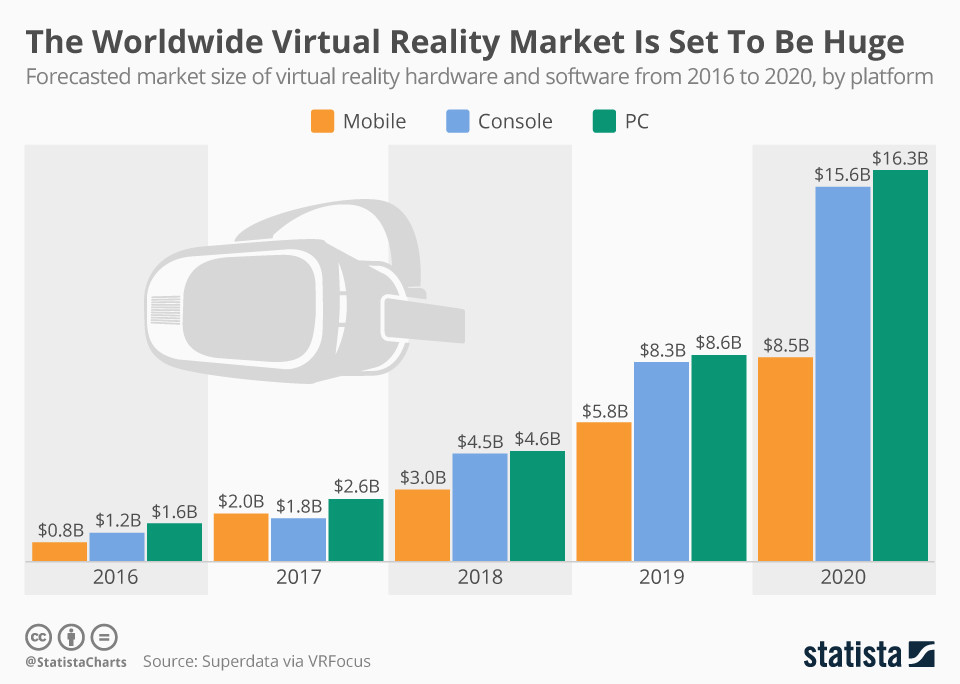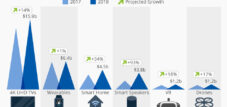+++ Who Leads the Virtual Reality Race? +++ Virtual Reality Has Yet to Make a Big Impression +++ Augmented Reality a $50 Billion Opportunity? +++ Virtual Reality Content Set To Outpace Hardware by 2018 +++ The Worldwide Virtual Reality Market Is Set To Be Huge +++ The Diverse Potential of VR & AR Applications +++ Holiday Season Marks First Reality Check for Virtual Reality +++ Is Virtual Reality the Next Big Thing? +++ Analysts Bullish on Smartwatches, Cautious on VR Breakthrough +++ Which VR Headset Holds the Pole Position? +++ Facebook-Oculus VR Is Tech’s Latest Billion-Dollar Deal +++
Who Leads the Virtual Reality Race?
After an eventful 2016 when numerous virtual reality headsets finally hit the market, 2017 has been relatively quiet in terms of new devices entering the scene. The market is still dominated by the same big players as Samsung (Gear VR), Sony (PlayStation VR) and Facebook (Oculus Rift) accounted for more than 60 percent of global VR and AR headset shipments in the second quarter of 2017.
According to IDC, global headset shipments grew 25.5 percent (year-over-year) in the second quarter, reaching 2.1 million units. Despite growing interest in augmented reality – Apple and Google both released an AR development kit for their mobile platforms this year – virtual reality still accounts for 98 percent of shipments in the AR/VR market. While it will probably take some time before we see the first consumer-focused AR headsets, we will soon get a glimpse of the technology through our mobile phones.
Virtual Reality Has Yet to Make a Big Impression
As Google’s developer conference I/O 2017 is about to kick off, rumor has it that the company might show off a new virtual reality headset at the event. The rumored headset reportedly won’t require a PC or a smartphone and is described as featuring “cutting-edge” technology.
So far, virtual reality has not lived up to the hype that surrounded the technology in recent years. Despite several headsets finally hitting the market in 2016, the consumer response to VR devices has been tepid at best.
According to Nielsen’s latest Games 360 report, very few Americans are seriously considering buying a VR headset. The reasons for the lack of interest are summed up by a separate study by Thrive Analytics, which finds that many consumers simply aren’t interested in virtual reality.
Augmented Reality a $50 Billion Opportunity?
While 2016 will go down as the year in which virtual reality finally became real for consumers, the industry has already set its eyes on the next prize. Industry heavyweights such as Google, Apple, Microsoft and Facebook are reportedly all working on augmented reality devices that some are already touting as the next ‘next big thing’.
With Sony, Facebook, Google and others all having released virtual reality headsets and an estimated 10 million units shipped in 2016, the technology clearly has a head start over augmented reality. And, according to a recent forecast published by IDC, AR headsets won’t be competing with VR devices in terms of unit sales anytime soon. The company’s analysts do however expect augmented reality headsets to become the much bigger market in terms of revenue. According to their estimates, the augmented reality market could reach nearly $50 billion a year by 2021, which would explain why every major player wants in on the party.
Because of the more sophisticated technology involved, future augmented reality devices are expected to be priced significantly higher than virtual reality headsets which, depending on the level of sophistication, can be bought for less than $100. According to IDC’s senior research analyst Jitesh Ubrani, such low-cost models may ultimately hurt VR technology more than they promote it. He argues that consumers who have a bad experience using an entry-level model may turn their backs on the tech altogether.
Virtual Reality Content Set To Outpace Hardware by 2018
These days, tech-enthusiasts are being bombarded with news on the latest virtual reality devices; all the while, VR content is being over-looked. This is in spite of the strong growth potential VR content holds.
Research by Tractica shows that VR content will overtake VR hardware as the strongest segment in regards to revenue generation in 2018. According to the market intelligence firm, revenues generated via the sale of head-mounted displays are expected to have almost doubled by 2020. This growth seems relatively minuscule. At least, compared to the six-fold increase to 14 million by 2020 U.S. dollars in revenue from VR content.
The Worldwide Virtual Reality Market Is Set To Be Huge
Google launched its fully fledged offering to the world of virtual reality, the Daydream. As the Statista infographic below shows, they could well be getting into a very lucrative market at just the right time. Looking at mobile alone, hardware and software is forecast by SuperData Research (via VRFocus) to hit 8.5 billion U.S. dollars by 2020, with the total worldwide market predicted to be worth 40.4 billion dollars.
The Diverse Potential of VR & AR Applications
While many consider virtual and augmented reality the next big thing, there still appears to be a degree of uncertainty about what both technologies can and will actually be used for. According to Goldman Sachs, who predict the industry reaching a value of $80 billion a year ($35 billion software and $45 billion hardware) by 2025, the potential of AR/VR tech is extremely diverse.
As many others do, Goldman Sachs’ researchers see video gaming as the industry’s most promising use case with live events and video entertainment being the other major consumer-focused applications of VR/AR technology.
The potential of the new technologies extends way beyond the consumer space though. According to Goldman Sachs’ estimates, almost half the industry’s revenue will be generated in the enterprise and public sector with healthcare and engineering being the most promising areas of use.
Holiday Season Marks First Reality Check for Virtual Reality
As the smoke from the multi-day shopping extravaganza that is Thanksgiving weekend clears, market researchers are having a feast on the intelligence they were able to gather over the past few days. How much did people buy? Where did they look for the best deals? And most importantly: what are the hottest items this holiday season? While we cannot answer all of these questions, SuperData, a research company specializing in games and interactive media, claims to know which product category wasn’t as hot as people had expected and, according to them, might even be the “biggest loser” of the past weekend. It’s virtual reality.
While 2016 was supposed to be the year of VR, we are still waiting for the technology’s big breakthrough. Despite the fact that several major players released virtual reality headsets over the past few months, many people still consider them novelty items rather than products that are ready to hit the mainstream in a major way. Reacting to the lack of excitement surrounding virtual reality on Black Friday and Cyber Monday, SuperData revised their 2016 forecast for VR headset shipments downward significantly. The company’s analysts are particularly underwhelmed by the launch of Sony’s PlayStation VR, which stands in the shadows of the recently released PlayStation 4 Pro both in terms of customer attention and Sony’s marketing efforts.
While the holiday shopping season certainly isn’t over yet, it appears as if it could turn out to be a harsh reality check for those who bet big on virtual reality.
Is Virtual Reality the Next Big Thing?
In 2016, Sony held a special event at the Game Developers Conference in San Francisco to present PlayStation VR, the company’s virtual reality headset aimed to compete with Facebook’s Oculus Rift and HTC’s Vive. The device, formally known as Project Morpheus, is built for Sony’s PlayStation 4 and will launch worldwide in October.
While virtual reality has been willingly adopted as the next big thing by the media, there remains some doubt about the technology’s mass appeal. A recent survey by Horizon Media does little to refute the skepticism surrounding virtual reality’s potential to become a mainstream hit.
According to the findings, 36 percent of consumers in the U.S. are interested in owning a VR device. However, no more than a quarter of the respondents would be willing to spend more than $250 on it. Considering the fact that Sony’s PlayStation VR headset is already on the cheaper side with its $399 price tag, it remains doubtful how many buyers the futuristic devices will find outside the hardcore gaming demographic.
Analysts Bullish on Smartwatches, Cautious on VR Breakthrough
Despite the feeling that the smartwatch hype has died down a bit following the slightly underwhelming launch of the Apple Watch last fall, analysts remain positive on the short-term outlook of smart wristwatches. Market research firm Gartner expects global smartwatch sales to more than double by 2017, quoting Apple’s marketing power as one of the keys to making connected watches a lifestyle item.
Often tagged as the big thing to watch in 2016, virtual reality headsets are also poised for significant growth in the next two years. However, industry experts remain cautious on the mainstream appeal of “head-mounted displays” such as Oculus Rift or the discontinued Google Glass project. While Gartner predicts global sales to increase from 0.14 million last year to more than 6 million units in 2017, that would still be far from mainstream adoption.
Which VR Headset Holds the Pole Position?
Virtual Reality is one of the hottest new markets in the tech world and virtually every big player in the industry is currently trying to claim a piece of it before it takes off. Facebook, Sony, Google and others have all at least pre-announced their own VR headset; Samsung’s Gear VR, which requires a Samsung smartphone to work, became available this week.
With 360-degree videos displayed on smartphones giving consumers a first taste of what’s to come, 2016 is supposed to be the breakthrough year for virtual reality headsets. But which company has done the best job of teasing its product to the public? According to a survey conducted by Statista earlier this year, Facebook’s Oculus Rift scores highest in terms of consumer awareness with 35 percent of the respondents having heard of it.
31 percent of the respondents had never heard of any Virtual Reality headset. Let’s see if the next twelve months will change that.
Facebook-Oculus VR Is Tech’s Latest Billion-Dollar Deal
Mar 26, 2014 – In the wake of Facebook’s $19 billion Whatsapp deal, Mark Zuckerberg has grabbed even more headlines with his acquisition of Oculus VR. The move has proved controversial amongst fans of the company’s virtual reality headet, the Oculus Rift, and is the latest in a series of billion-dollar deals amongst America’s leading tech firms.


